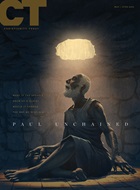
The website for 99.1 JOY FM in St. Louis features a scrolling playlist of its lineup of Christian pop music and a “listen now” button to tune in to the simulcast broadcast. But visitors may find that after a few hours of streaming artists like Lauren Daigle and Brandon Lake, the site may kick them off.
Because of higher royalty costs, many noncommercial religious broadcasters are choosing to either limit the number of online listeners they allow at a time or simply not promote their online platforms at all. A new lawsuit from some of these broadcasters, including many Christian stations, claims that their royalty rate, which exceeds what other stations pay, is effectively a form of religious discrimination.
“The government is charging religious broadcasters a significantly higher rate,” said Rory Gray, with the Alliance Defending Freedom (ADF). “It suppresses religious speech in the public sphere.”
Noncommercial radio stations—which rely on listener support and grant funding rather than ad sales—have traditionally been able to negotiate lower royalty rates for the music they play. But religious broadcasters, like JOY FM’s owner, Gateway Creative Broadcasting, lost out on that deal during negotiations in 2016 with SoundExchange, the rights management company that distributes royalties to artists.
Then streaming costs for religious radio increased in 2021, following a ruling from the US Copyright Royalty Board (CRB), and Christian stations were subject to the standard rates. A suit filed in February against the board claims that due to the discrepancy in rates set by the CRB and privately negotiated rates, noncommercial religious broadcasters are forced to restrict their streams in ways other noncommercial stations, like public radio, are not.
“Noncommercial religious broadcasters are now paying rates at a commercial level,” said Gray, who serves as counsel for the National Religious Broadcasters Noncommercial Music License Committee in the case. “They just want to pay a fair rate, the same rate that the secular NPR stations are paying.”
According to ADF, noncommercial religious broadcasters are now paying a rate 18 times higher than the average rate given to NPR stations. (Both public radio and college radio stations privately negotiated deals with SoundExchange.)
Some in the Christian music industry are cheering the changes in royalty agreements since they help artists make profit. The lower rates for noncommercial religious broadcasters have historically resulted in Christian artists receiving far less royalty revenue than their mainstream peers.
In a 2023 article for Billboard magazine, Malcolm Hawker, chief operating officer for SESAC Music Group and former president and CEO of Christian Copyright Licensing International (CCLI) said that the regulatory system around radio, especially when it comes to Christian radio, is broken.
Referring to K-LOVE’s parent company, Educational Media Foundation, Hawker said that nonprofit status obscures the reality that EMF is a financial powerhouse with over $1 billion in assets.
“This is a far cry from the small volunteer-run community stations the CRB rates are meant to protect,” Hawker wrote. “I believe that it’s inherently unfair for these networks to exploit the CRB rate structure that’s available to educational radio stations given their financial profiles and the significant amount of money they raise using music to build a large audience.”
Hawker focuses primarily on royalty structures for airtime, while the case ADF is making on behalf of religious stations has to do with royalty fees for online streaming. But the problem Hawker identifies is the same: that Christian artists generally see lower royalty revenue in part because most of the broadcasters that program their music pay noncommercial rates.
ADF says that this case isn’t about giving religious broadcasters the right to pay artists less but rather about the higher royalty rate compared to NPR stations. “If the rate was the same, we wouldn’t have a discrimination case,” said Gray.
In a statement, ADF senior counsel John Bursch said, “Religious broadcasters should have the freedom to exercise their faith and free speech without discrimination, but government officials are forcing them to pay exorbitant fees or have their constitutionally protected speech suppressed.”
NPR stations are also classified as noncommercial broadcasters and are eligible for funding from the Corporation for Public Broadcasting, which does not fund organizations whose programming “furthers the principles of particular political or religious philosophies.”
Because NPR was able to reach a private agreement with SoundExchange while the National Religious Broadcasters Noncommercial Music License Committee was not, the CRB rates apply to nonreligious commercial broadcasters but not to NPR. The CRB rates kick in for noncommercial religious stations with an average audience size of 218 listeners or more.
ADF says that this is, effectively, religious discrimination, even though SoundExchange, which is not technically a party in the lawsuit, contributed to the current state of conflict.
According to Gray, the Supreme Court will determine whether they will hear the case in mid-June. For the time being, religious broadcasters are stuck with the rates set by CRB. SoundExchange has also filed an appeal, arguing that the CRB’s 2021 ruling did not do enough to bring rates for webcasters in line with streaming services.
As the music industry struggles to adjust to a landscape dominated by streaming and social media, radio broadcasters are trying to modernize and find their place in it. Some industry veterans insist that the future of radio is online streaming, so the survival of noncommercial religious broadcasters depends on their ability to find a sustainable model under increasingly streaming-centric rules and regulations.

Support Our Work
Subscribe to CT for less than $4.25/month


















